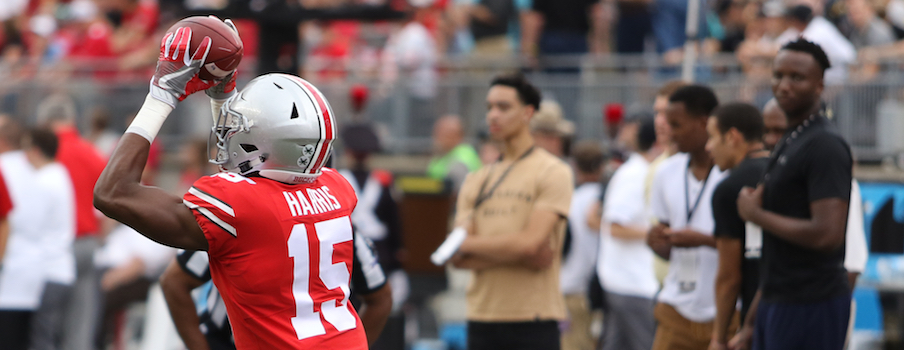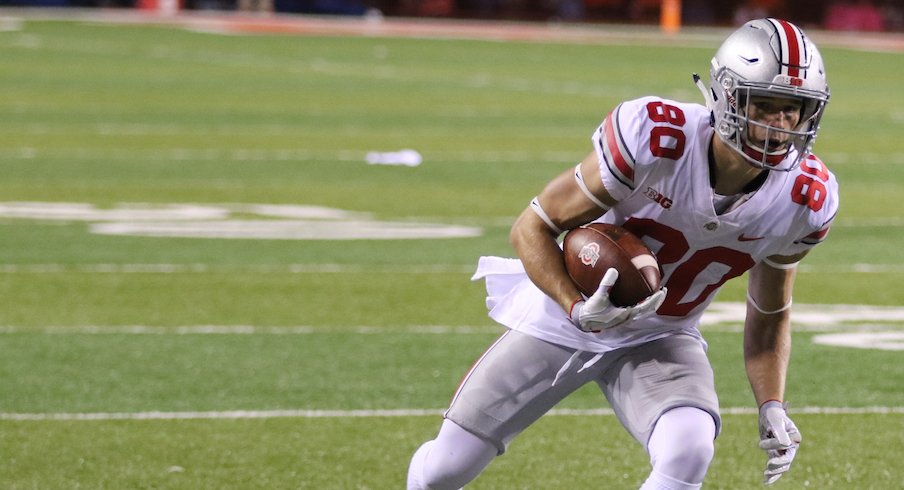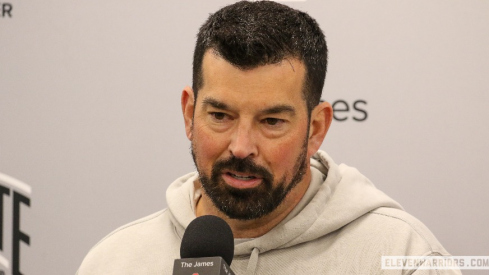Of all the positions where Ohio State has to decide how to balance playing time between deep groups of talented players this season, one of the most fascinating to watch could be the wide receiver rotation.
At a position where the Buckeyes typically have three players on the field at once, Ohio State has six wide receivers who played enough last season to be considered co-starters – and all of them are back on this season’s roster, along with several other receivers who have also made a strong case to earn playing time.
Theoretically, Ohio State could play as many as seven, eight or even nine wide receivers in its regular rotation this season.
Whether the Buckeyes should do that, however, is a question with no easy answer.
Because Ohio State likes to rotate its receivers regularly over the course of a game, the Buckeyes had six wide receivers who played more than 300 snaps last season: Terry McLaurin and Johnnie Dixon at the "Z" receiver position, Austin Mack and Binjimen Victor at the "X" and Parris Campbell and K.J. Hill in the slot.
Campbell and McLaurin are both returning captains, and Dixon could also be a captain this year as a fellow fifth-year senior. Hill was the Buckeyes’ leader in receptions last season. Mack is arguably the best downfield receiver on the team, and while Ohio State head coach Urban Meyer has said that Victor needs to "keep getting better," Meyer has also described Victor as "one of the most talented receivers" he has ever had.
The Buckeyes also have at least three other receivers, though, who have a real case to see more playing time this season. Jaylen Harris, a 6-foot-5 sophomore with the size and athleticism to be a big-time weapon on the outside, was "very close to being in the rotation" after the spring game, Meyer said. Demario McCall, an explosive H-back who perhaps offers as much big-play potential as anyone in the receiver room, is another player the Buckeyes want to get on the field more. And C.J. Saunders, a former walk-on who impressed in limited playing time last season, is also a candidate to earn more playing time after being placed on scholarship last month.
Hypothetically, that means Buckeyes could go three-deep with their rotation at every receiver position if they want to. Ultimately, however, the Buckeyes need to do what’s best for their offense – and that might not be.
Ohio State is likely to do something to mix things up at the wide receiver position, because it isn’t satisfied with the status quo. Meyer said this spring that the Buckeyes "have been good" but "have not been elite" at the position over the past few seasons, challenging wide receivers coach Zach Smith to take his position group’s play to another level in 2018.
Playing more wide receivers on a regular basis won’t necessarily make that happen, though, as Smith said this spring that for his receivers to go from good to elite, they "just need to be more consistent."
"We need to make big plays when plays present themselves and in big games," Smith said. "And so, we did that at times (last season), just wasn’t as consistent as we wanted it to be."
If consistency is what the Buckeyes are looking for, it’s arguable that they’d be better off playing less receivers.
One problem for Ohio State’s offense last season – in contrast to what they had in other recent seasons with Devin Smith and Michael Thomas in the downfield passing game and Curtis Samuel at H-back – is that while the Buckeyes had six solid wide receivers, they didn’t have one receiver who emerged as a consistent big-play target. While the Buckeyes don’t necessarily need to have a true No. 1 receiver, especially if they have a multitude of receivers they can rely on, the rotation among them has also arguably made it more difficult for any one of them to emerge as a go-to threat.
Some Buckeye fans believe that a new quarterback is the key ingredient for Ohio State’s wide receivers to make more plays, but that all depends on the rapport Dwayne Haskins (and Tate Martell, assuming he sees some playing time) is able to build with those receivers. And constantly rotating any more than six receivers with the first-team offense could make it more difficult for Haskins to build that rapport.
If Harris, McCall, Saunders or any other receivers prove that they are among the team’s best receivers, some of Ohio State’s top receivers from last season just might be in jeopardy of losing their spots in the rotation, as Smith insisted this spring that the Buckeyes will play their best receivers regardless of experience.

All of that said, the Buckeyes aren’t likely to cut any of their experienced receivers out of the rotation entirely, while they also need to see what their other receivers can do and whether they can make the offense better. Fortunately for the Buckeyes, their first two games of the season against Oregon State and Rutgers are games they should be able to win comfortably enough to experiment with various combinations of receivers and see who performs best.
By the Buckeyes’ third game of the season against TCU, though, when Ohio State will likely face its first real test of the year, Smith could have some tough decisions to make about how his wide receivers should rotate. Because in situations where the Buckeyes need their offense to make consistent plays – and potentially big plays with games on the line – alternating series between a rotation of more than six receivers probably won’t be their best option.
Certainly, having more talented receivers than readily available playing time is a good problem for the Buckeyes to have. It surely beats the alternative of not having enough receivers who are ready to play, and it puts the Buckeyes in a good position to overcome any injuries they might suffer at the position, while also allowing them to substitute as much as they need to ensure that the receivers they have on the field are fresh.
It still leaves the Buckeyes with a challenging dilemma, though, of figuring out how to manage playing time among that multitude of receivers – none of whom have truly separated themselves from the pack as stars, although they have shown varying abilities to make plays – in the way that puts Ohio State’s 2018 offense in the best position to succeed.


